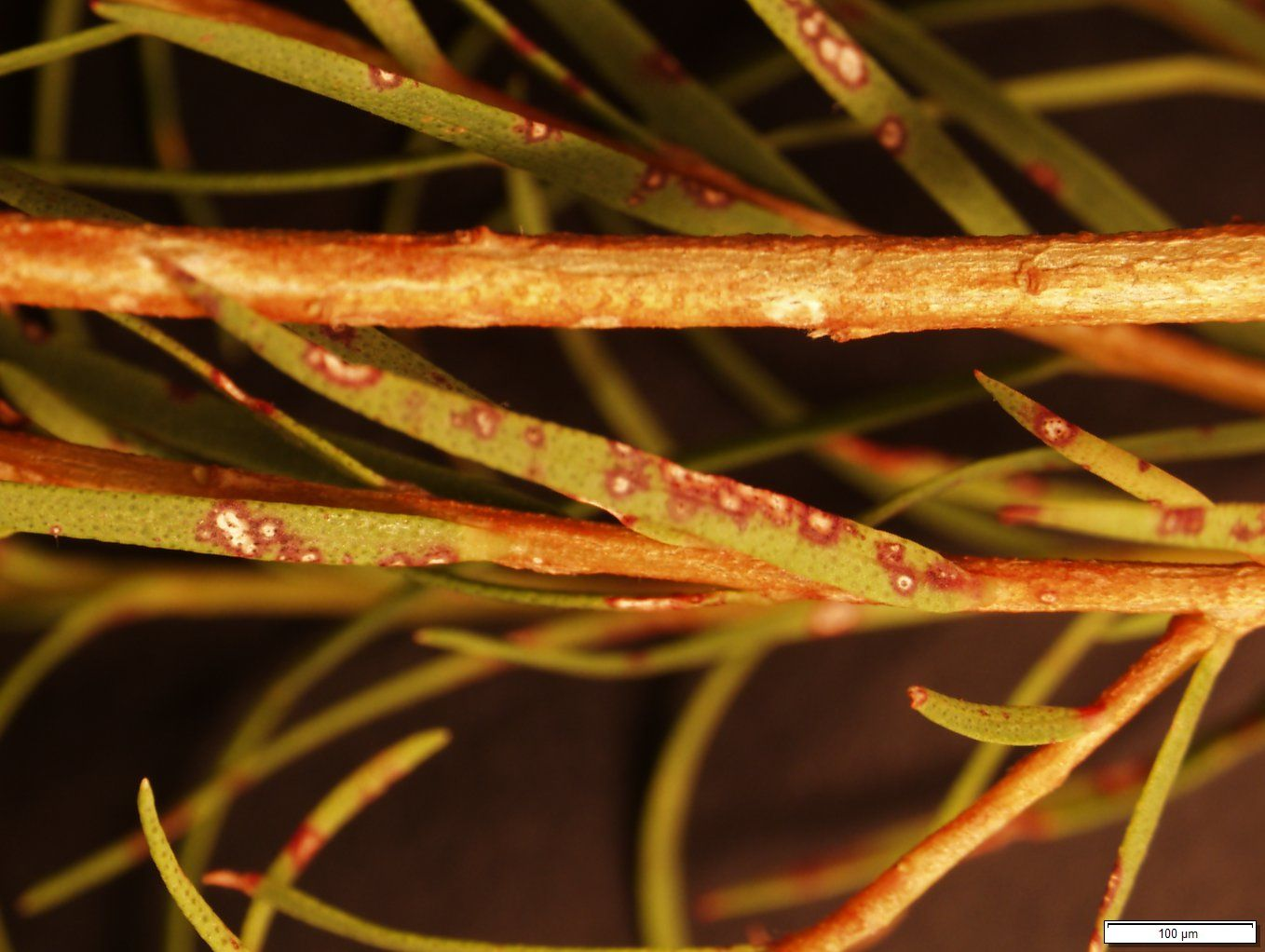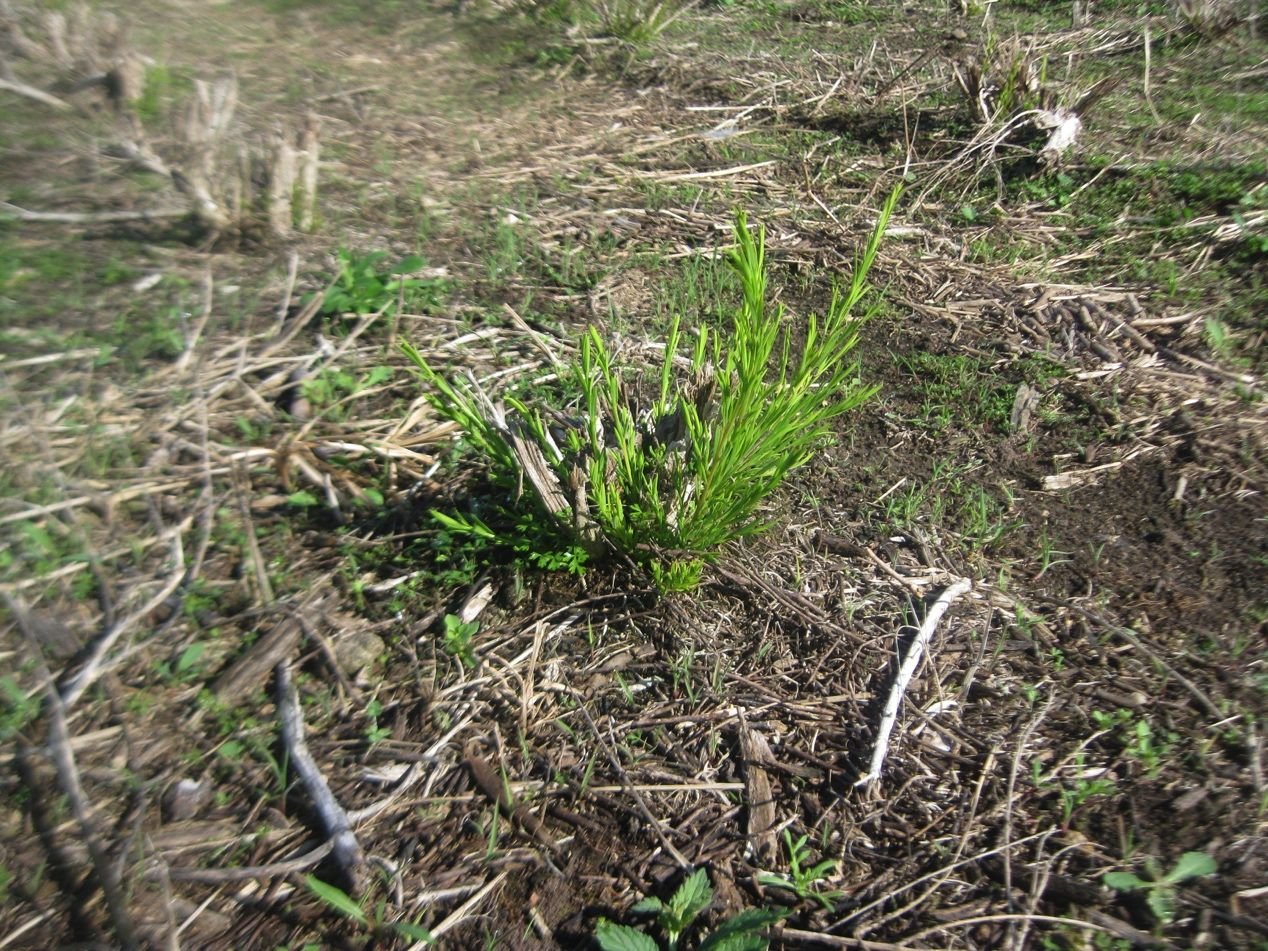Elsinoë scab (Elsinoë eelemani) of Tea Tree (Melaleuca alternifolia)
Introduction
Elsinoë eelemani is a fungus that causes scabby lesions to develop on infected Tea Tree (Melaleuca alternifolia) leaves and stems (Figure 1). The disease, Elsinoë scab, has been reported to occur in Tea Tree for more than 20 years. Disease incidence and severity vary between plantations but typically develop following periods of persistent or frequent moisture.
Figure 1. Symptoms of Elsinoë scab: scabby lesions on leaves and stems of Melaleuca alternifolia caused by Elsinoë
Yield losses as high as 50% have been reported in some plantations. Severe symptoms have been associated with extended periods of wet weather, storm events, flooding and poorly draining soils, dense canopies, and ineffective management of insect pests. Some plantations currently experience very little, if any, Elsinoë scab. Frequent, more intense storms could potentially exacerbate this disease.
Elsinoë: the story
A charming background to the origin of Elsinoë is given by Miles et al (2015). To retell briefly, Elsinoë was introduced by Raciborski (1900) to describe a fungus that caused scabs on plant tissues. The first species described was E. canavaliae from Java, Indonesia. The name Elsinoë was taken from the heroine in the play Iridion, written by the Polish dramatist and poet Zygmunt Krasiński in 1836 (Saccardo and Sydow 1902). There are now at least 48 species of Elsinoë, 15 of which have been recorded in Australia (Kirk et al. 2008; Shuttleworth et al. 2016).
The Elsinoë species that affects Tea Tree (Melaleuca alternifolia) was described as E. eelemani after the legendary Princess Eelemani of the Bundjalung people (Shuttleworth et al. 2016).
What does Elsinoë scab look like?
Small, red-purple lesions appear on leaves around 10 days after infection. A pale, grey-beige centre forms in the middle of the red lesion (Figure 1). Lesions on stems are pale pink in colour but stems may become dark red if the lesions progress (Figure 2). In severely affected plants, lesions may coalesce, and leaves are girdled and killed off, leaving defoliated twigs at the tips of plants (Figure 3). In severe cases plants may be stunted and the loss of leaf biomass results in a lower oil yield.
Figure 2. Stems may appear red if the lesions develop and coalesce
Figure 3. In severely affected plants, lesions may coalesce, and leaves are girdled and killed off, leaving defoliated twigs at the tips of plants
When does infection occur?
Plant disease requires the presence of the (a) pathogen (b) susceptible plant tissue and (c) favourable environmental conditions.
For Elsinoë scab to develop this requires:
(a) A source of spores. This can include lesions on leaves and stems within the current crop, lesions on leaf litter or stumps from the previous season, or planting material from the nursery.
Elsinoë spores are released from lesions on infected plant tissues when conditions are wet for at least 4 hours and temperatures are between 15 oC and 25oC. When moisture is present, these spores infect the immature leaf and stem tissues of M. alternifolia.
(b) Young shoots and leaves. Only young plant tissues are susceptible to infection;
Tea Tree is harvested annually by coppicing. The tree stumps are retained and produce new shoots for the following season’s crop (Figure 4). New leaves and shoots continue to develop on Tea Tree throughout the growing season. This growing, immature plant tissue is susceptible to infection. Older material can act as a source of inoculum, but is no longer able to be infected.
(c) Persistent or frequent moisture, from rain, dew or soil moisture, is required for conidia to develop, and for infection to take place. The presence of moisture can depend on rainfall events, soil moisture holding capacity and canopy density
Water, wind and other disturbances help to spread the fungus through the canopy and the plantation.
Where does the inoculum come from and how does it spread?
Elsinoë inoculum (spores) can arise from current season crops in the plantation, or previous seasons plant material remaining on the ground. Although mature plant tissues are not susceptible to infection, lesions on mature leaves and stems can produce spores when wet. Spores can also originate from from infected stumps and leaf litter to infect new shoots following harvest. The pathogen can remain viable for at least 4 months in leaf litter.
Spores spread from infected plant tissues to infect new growth primarily via movement of water, but can also move short distances in wind blown moisture. Insects may carry Elsinoë propagules but are unlikely to be active vectors of the fungus. Insects are more likely to contribute to disease severity by providing entry points for the pathogen. Similarly, damage to crops from severe storms, or vehicle traffic may also contribute to wounding and entry points for the pathogen.
Figure 4. The tree stumps are retained and produce new shoots for the following season’s crop. Spores from infected leaf litter remaining on the ground after harvest can infect the new growth
Management of Elsinoë
Use clean, uninfected nursery stock to establish new plantations
Monitor crops to detect disease symptoms early and enable prompt treatment
If using fungicides, apply promptly when conditions favour infection to protect new shoots from infection. Use more effective fungicides, and rotate chemicals.
Where possible, avoid water build up in the crop (eg. improved drainage, change harvest times to coincide with new shoot growth during dryer periods)
Avoid moving machinery through the crop when conditions are wet
Manage insects and to avoid wounding and potential entry points for the pathogen
Summary
Frequent and continuous monitoring of environmental conditions and disease levels are required, to ensure prompt application of control measures, from the start of the growing season. Where inoculum is reduced, and infection is impeded at the beginning of the season, inoculum build up and inoculum pressure later in the season may be reduced.
References
Miles AK, Tan YP, Shivas RG and Drenth A (2015). Novel pathotypes of Elsinoë australis associated with Citrus australasica and Simmondsia chinensis in Australia. Tropical Plant Pathology 40: 26-34. https://doi.org/10.1007/s40858-015-0005-0
Shuttleworth LA, Scarlett K, Guest DI, Entwisle P, Daniel R (2016) Elsinoë eelemani sp. nov. Fungal Planet Description Sheet 474 In: Crous et al. (2016) Fungal Planet Description Sheets 469-557. Persoonia - Molecular Phylogeny and Evolution of Fungi, 37 (186), pp. 236-237. https://doi.org/10.3767/003158516X694499




